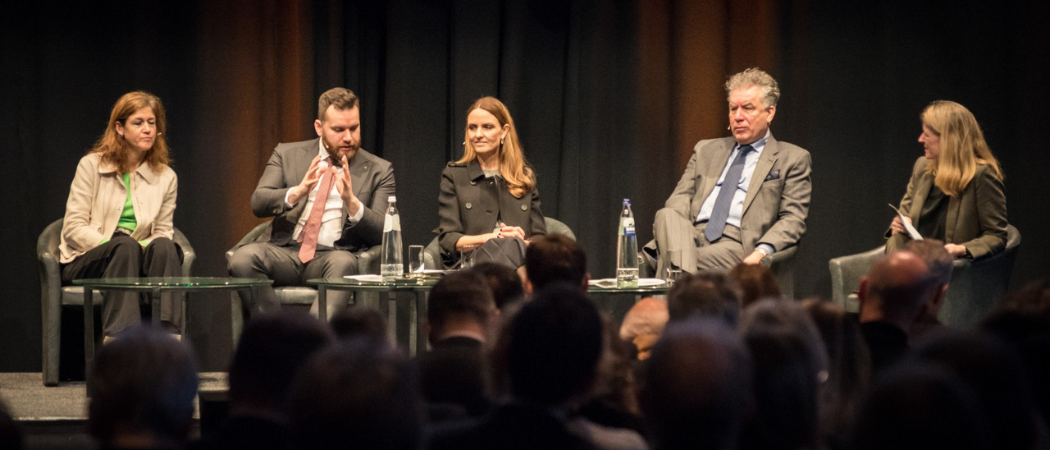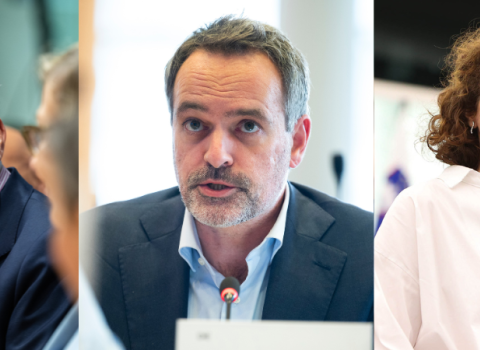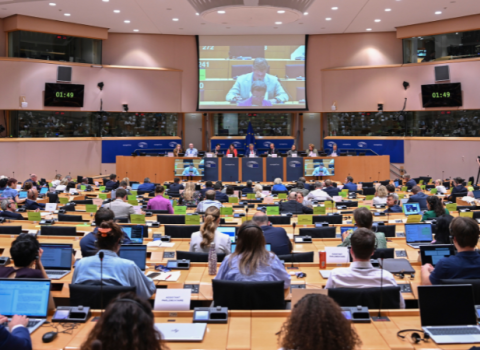There will be a successor to Horizon Europe, Science|Business conference hears, but expect a battle over budgets and instruments

From left to right: Annelien Bredenoord, President of the Executive Board at Erasmus University Rotterdam; Pavel Doleček, Deputy Minister for Science, Research, and Innovation for the Government of the Czech Republic; Nanna-Louise Linde, Vice President of European Government Affairs at Microsoft; MEP Christian Ehler; and Maryline Fiaschi, CEO of Science|Business. Photo credits: Jeroen Vanhecke
A leading member of the European Parliament has reassured the research and innovation community that there will be an FP10, despite concerns that the next EU research Framework Programme could be swallowed up in a political drive to boost economic competitiveness.
“There will be a Framework Programme 10,” said Christian Ehler, a prominent member of the Parliament’s research and industry committee, at the annual Science|Business conference on Thursday.
He was responding to speculation that, instead of a standalone programme to succeed Horizon Europe in 2028, research and innovation would be placed within an overarching competitiveness fund. The absence of FP10 from the Commission’s recently published Competitiveness Compass strategy has only fed such fears.
According to Ehler, the problem is not so much the budget as the financial instruments used, for example to deliver the work of the European Innovation Council (EIC). But research and innovation will have its own budget line, he said.
This does not mean the next round of negotiations will be plain sailing. Victor Negrescu, Parliament’s negotiator for the 2025 EU budget, said in a video message that discussions with the Council and Commission on his watch had been “intense and difficult.”
MEPs finally convinced member states not to proceed with €400 million in cuts to Horizon Europe, but the negotiations showed that “beyond the nice rhetoric [. . .] we have difficulties in matching our declarations with numbers,” he said.
Negrescu said he shared the academic community’s concern that the Commission’s competitiveness plan does not sufficiently reflect the importance of research and innovation.
“We need specific structures, we need predictability for research, we need also to make sure that we are defending the research programme,” he said. “We need, once more, to underline the need to have clarity, and not give opinions about research and innovation without consulting the ecosystem.”
The Romanian MEP also called for measures to ensure equal funding for researchers in eastern and western Europe.
Misguided targets
The Competitiveness Compass was also criticised for reiterating the target of raising public and private investments in R&D to 3% of GDP in each member state. Such targets are “misguided,” argued Daniel Gros, director of the Institute for European Policymaking at Bocconi University.
Gros co-authored a report on escaping the middle-technology trap, referring to the fact that Europe’s biggest R&D spenders are in traditional industries such as the automotive sector, whereas US companies invest more in high-tech sectors. This concept was later picked up in the influential Draghi report on European competitiveness.
“Do we want our car industry to invest even more in how to produce cars? It doesn’t make sense,” Gros said. “We should get away from these numerical, quantitative definers; we should look at the composition and the quality [of R&D].”
Rather than thinking about R&D expenditure, which is an input, policymakers should also look at the output, and ask whether it is possible to get more value for money.
In addition to reforming the EIC to provide greater support for breakthrough innovation, Gros said that Pillar 2 of Horizon Europe, which funds collaborative research and includes large public-private partnerships, could be improved.
“The evidence we are collecting is that it’s very difficult to find a permanent positive impact of the funding received by most enterprises,” he said.
Enhancing tech adoption
Other speakers argued for a narrower research and innovation strategy alongside any budget increase. Nanna-Louise Linde, vice-president of European government affairs at Microsoft, said efforts should be focused on technology fields where the EU is strong.
“We are far behind Europe’s own AI adoption goals,” she said. “The [EU] target is for 75% of companies to adopt AI by 2030, yet [adoption rates are] somewhere between 7% and 11% at the moment, way behind the US and China.”
In the last 12 months, Microsoft invested €17 billion in infrastructure in Europe, including power grids and data centres. However, more is needed to enhance the technology, including partnerships, collaboration and training.
The need for a more positive public attitude toward research, innovation and new technologies was also raised by other speakers. Education has a role to play in this respect, they said.





 A unique international forum for public research organisations and companies to connect their external engagement with strategic interests around their R&D system.
A unique international forum for public research organisations and companies to connect their external engagement with strategic interests around their R&D system.